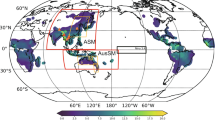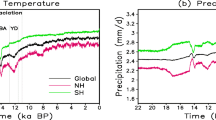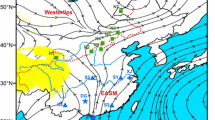Abstract
There is a scientific debate on the relationship between ancient winter and summer monsoons in East Asia. Some scholars think that East Asian winter and summer monsoons are anti-correlated, and others think not. For this reason, this study is motivated to assess their linkage from the paleoclimate simulation perspective, through analyzing the Last Glacial Maximum (LGM) and mid-Holocene (MH) climate simulated by CCSM3 model. Compared to the present climate, the Aleutian low is found to be deepened and the East Asian winter monsoon (EAWM) is stronger during the LGM winter. The Pacific high in summer is noticed to be weakened and the East Asian summer monsoon (EASM) is weaker at the LGM. During the MH, the Aleutian low and the Asian high in winter are intensified, and the Asian low and the Pacific high in summer are enhanced, indicating that the EAWM and EASM are both stronger than today. Therefore, the EAWM is not always negatively correlated to the EASM. Their relationship may be different at different geological stages. It can be obtained at least from the numerical simulation results that the EAWM and the EASM is negatively correlated during the cooling period, while positively correlated during the warming period.
Similar content being viewed by others
References
Flohn H. Large-scale aspects of the “summer monsoon” in South and East Asia. J Meteorol Soc Jpn, 1957, 75: 180–186
Murakami T, Matsumoto J. Summer monsoon over the Asian continent and western North Pacific. J Meteorol Soc Jpn, 1994, 72: 719–745
Zhao P, Zhang R H, Liu J P, et al. Onset of southwesterly wind over eastern China and associated atmospheric circulation and rainfall. Clim Dyn, 2007, 28: 797–811
Zhao P, Zhou X J, Chen L X, et al. Characteristics of subtropical monsoon and rainfall over eastern China and western North Pacific and associated reasons (in Chinese). Acta Meteorol Sin, 2008, 66: 940–954
Yancheva G, Nowaczyk N R, Mingram J, et al. Influence of the intertropical convergence zone on the East Asian monsoon. Nature, 2007, 445: 74–77
Zhang D E, Lu L H. Anti-correlation of summer/winter monsoons? Nature, 2007, 450: doi:10.1038/nature06338
Yu G, Chen X, Liu J, et al. Preliminary study on LGM climate simulation and the diagnosis for East Asia. Chinese Sci Bull, 2001, 46: 364–368
Liu J, Yu G., Chen X. Paleoclimate simulation of 21 ka for the Tibetan Plateau and Eastern Asia. Clim Dyn, 2002, 19: 575–583
Zhao P, Chen L X, Zhou X J, et al. Modeling the East Asian climate during the last glacial maximum. Sci China Ser D-Earth Sci, 2003, 46: 1060–1068
Jiang D B, Wang H J, Drange H, et al. Last glacial maximum over China: sensitivities of climate to paleovegetation and Tibetan ice sheet. J Geophys Res, 2003, 108: 4102, doi:10.1029/2002JD002167
Ju L X, Wang H J, Jiang D B. Simulation of the Last Glacial Maximum climate over East Asia with a regional climate model nested in a general circulation model. Palaeogeogr Palaeoclimatol Palaeoecol, 2007, 248: 376–390
Jiang D B. Vegetation and soil feedbacks at the Last Glacial Maximum. Palaeogeogr Palaeoclimatol Palaeoecol, 2008, 268: 39–46
Wang H J. The seasonal climate and low frequency oscillation in the simulated mid-Holocene megathermal climate. Adv Atmos Sci, 2000, 17: 445–457
Wang H J. The mid-Holocene climate simulated by a grid-point AGCM coupled with a biome model. Adv Atmos Sci, 2002, 19: 205–218
Chen X, Yu G, Liu J. Simulation of the Holocene Optimum climate in East Asia and its temperature change mechanism. Sci China Ser D-Earth Sci, 2002, 32: 335–345
Wei J F, Wang H J. A possible role of solar radiation and ocean in the mid-Holocene East Asian monsoon climate. Adv Atmos Sci, 2004, 21: 1–12
Jin L Y, Wang H J, Chen F H, et al. A possible impact of cooling over the Tibetan Plateau on the mid-Holocene East Asian monsoon climate. Adv Atmos Sci, 2006, 23: 543–550
Zhou B T, Zhao P. Analysis of the coupled simulation result of the seasonal evolution of the southwesterly wind climate over eastern China in the mid-Holocene (in Chinese). Quat Sci, 2009, 29: 211–220
Braconnot P, Otto-Bliesner B, Harrison S, et al. Results of PMIP2 coupled simulations of the Mid-Holocene and Last Glacial Maximum. Part 1: experiments and large-scale features. Clim Past, 2007, 3: 261–277
Collins W D, Bitz C M, Blackmonand M L, et al. The Community Climate System Model version 3 (CCSM3). J Clim, 2006, 19: 2122–2143
Peltier W R. Global glacial isostasy and the surface of the ice-age Earth: the ICE-5G (VM2) model and GRACE. Annu Rev Earth Planet Sci, 2004, 32: 111–149
Otto-Bliesner B L, Brady E C, Clauzet G, et al. Last Glacial Maximum and Holocene climate in CCSM3. J Clim, 2006, 19: 2526–2544
Chen L X, Zhu Q G, Luo H B, et al. East Asian Monsoon (in Chinese). Beijing: Meteorological Press, 1991. 1–362
Ding Y H, Li C Y, Liu Y J. Overview of the South China Sea Monsoon Experiment(SCSMEX). Adv Atmos Sci, 2004, 21: 343–360
Guo Q Y. The summer monsoon intensity index in East Asia and its variation(in Chinese). Acta Geogr Sin, 1983, 38: 207–216
Shi N, Zhu Q G, Wu B G. The East Asian summer monsoon in relation to summer large scale weather-climate anomaly in China for last 40 years (in Chinese). Sci Atmos Sin, 1996, 20: 575–583
Zhao P, Zhou Z J. East Asian subtropical summer monsoon index and its relationships to rainfall (in Chinese). Acta Meteorol Sin, 2005, 63: 933–941
Berger A L. Long-term variations of daily insolation and Quaternary climatic changes. J Atmos Sci, 1978, 35: 2362–2367
Yanase W, Abe-Ouchi A. The LGM surface climate and atmospheric circulation over East Asia and the North Pacific in the PMIP2 coupled model simulations. Clim Past, 2007, 3: 439–451
Zhao Y, Braconnot P, Marti O, et al. A multi-model analysis of the role of the ocean on the African and Indian monsoon during the mid-Holocene. Clim Dyn, 2005, 25: 777–800
Jiang D B, Wang H J, Ding Z L, et al. Modeling the middle Pliocene climate with a global atmospheric general circulation model. J Geophys Res, 2005, 110: D14107, doi: 10.1029/2004JD005639
Shi Y F, Kong Z C, Wang S M, et al. Basic features of climates and environments during Holocene Megathermal in China. In: Shi Y F, Kong Z C, eds. The Climates and Environments of Holocence Megathernal in China (in Chinese). Beijing: China Ocean Press, 1992. 1–18
Winkler M G, Wang P K. The late quanternary vegetation and climate of China. In: Wright H E, Kutzbach J E, Webb T, et al. eds. Global climates since the Last Glacial Maximum. London: University of Minnesota Press, 1993. 221–264
Yu G, Chen X, Ni J, et al. Palaeovegetation of China: a pollen data-based synthesis for the mid-Holocene and last glacial maximum. J Biogeogr, 2000, 27: 635–664
Kohfeld K E, Harrison S P. How well can we simulate past climates? Evaluating the models using global palaeoenvironmental datasets. Quat Sci Rev, 2000, 19: 321–346
Yu X F, Zhou W J, Franzen L G, et al. High-resolution peat records for Holocene monsoon history in the eastern Tibetan Plateau. Sci China Ser D-Earth Sci, 2006, 49: 615–621
Wang S Y, Lü H Y, Liu J Q, et al. The early Holocene optimum inferred from a high-resolution pollen record of Huguangyan Maar Lake in southern China. Chinese Sci Bull, 2007, 52: 2829–2836
Yu G, Wang S M. Studies of the climatic dynamics for the mid-Holocene vegetation changes in China. Acta Micropalaeontol Sin, 2000, 17: 147–154
Wang H J. Role of vegetation and soil in the Holocene megathermal climate over China. J Geophys Res, 1999, 104: 9361–9367
Author information
Authors and Affiliations
Corresponding author
Additional information
Supported by the National Basic Research Program of China (Grant Nos. 2007CB 815901 and 2009CB421407)
About this article
Cite this article
Zhou, B., Zhao, P. Inverse correlation between ancient winter and summer monsoons in East Asia?. Chin. Sci. Bull. 54, 3760–3767 (2009). https://doi.org/10.1007/s11434-009-0583-7
Received:
Accepted:
Published:
Issue Date:
DOI: https://doi.org/10.1007/s11434-009-0583-7




